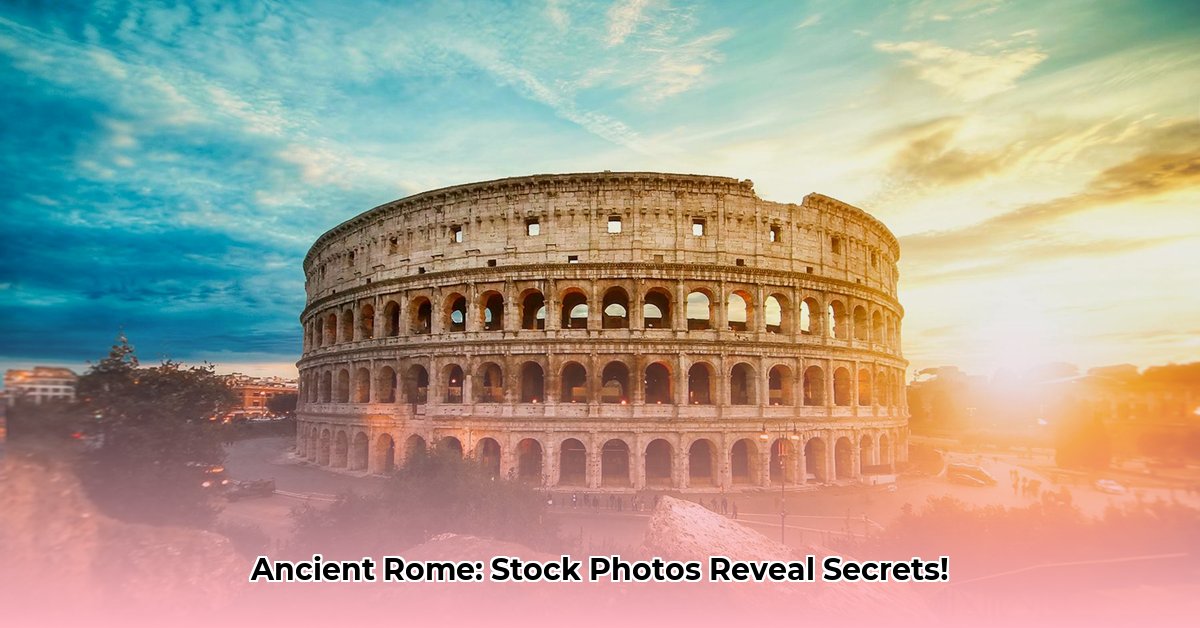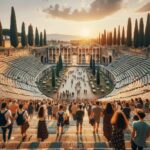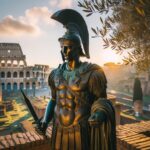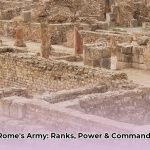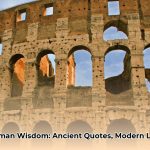What truly springs to mind when you envision Ancient Rome? Is it the majestic silhouette of the Colosseum, the weathered stones of the Roman Forum, or a stern marble bust of an emperor? These ancient Rome pictures, ubiquitous and instantly recognizable, dominate our digital landscapes, shaping a collective imagination of one of history’s most influential civilizations. Consider the social hierarchy; read about Rome’s complex social structure here. Yet, do these pervasive visuals genuinely capture the intricate, multi-layered story of Roman life and legacy? This article critically examines the visual narrative presented by readily available ancient Rome stock photos, highlighting their inherent limitations and advocating for a more expansive, historically accurate, and truly representative portrayal of this pivotal era.
The Illusion of Familiarity: What Common Imagery Reveals and Conceals
Our initial visual encounters with Ancient Rome are almost always filtered through a select few iconic images. The grandeur of the Colosseum’s ruins, the austere dignity of imperial statues, and the skeletal remains of the Roman Forum are the “usual suspects” among ancient Rome pictures found on commercial platforms. While undeniably powerful and visually striking, these common visuals predominantly emphasize monumental architecture and figures of authority, inadvertently creating a narrow—and potentially misleading—perception of Roman society. Such images, though impactful, offer only a partial glimpse into a truly vast, dynamic, and complex historical period. The commercial drive inherent in stock photography often prioritizes instantly recognizable symbols over nuanced historical representation, reinforcing an already simplified visual lexicon.
The Critical Gaps: Overlooked Realities of Roman Life
The overwhelming prevalence of certain ancient Rome pictures means that significant aspects of Roman life, its diverse populace, and its vast empire are often marginalized or entirely absent from the popular visual narrative. This creates profound gaps in our collective understanding of Roman visual culture.
- Where are the everyday people? The dominant visual narrative disproportionately centers on the elite: emperors, senators, and soldiers. Yet, the overwhelming majority of Roman citizens were ordinary individuals – the diligent farmers tilling fields, skilled artisans crafting goods, bustling merchants exchanging wares, and the vibrant lives of women, children, and the vast, often unseen, population of enslaved people. Their daily routines, struggles, contributions, and personal anecdotess are rarely depicted in easily accessible imagery, leaving a significant void in our collective understanding of Roman daily life. It’s akin to attempting to grasp modern society by observing only skyscrapers and powerful political leaders, ignoring the vibrant tapestry of urban life below.
- More Than Just Ruins: The Dynamic City: The pervasive focus on crumbling ruins—while historically significant—can anachronistically suggest a static, “dead” civilization. Ancient Rome was, in fact, a vibrant, bustling metropolis, a living, breathing hub of activity. Markets thrived with commerce, homes buzzed with domestic life, and public spaces teemed with social interaction, political discourse, and religious ceremonies. Contrasting fragmented ruined structures with meticulously researched artistic renderings or dynamic digital reconstructions of their prime allows for a far more accurate and engaging portrayal of the city’s astonishing dynamism and evolution over centuries.
- The Forgotten Multiculturalism of the Empire: Ancient Rome functioned as the beating heart of an expansive, multicultural empire, incorporating incredibly diverse populations from the chilly reaches of Britannia to the sun-baked landscapes of North Africa and the rich cultural centers of the Near East. However, many ancient Rome pictures present a strikingly homogenous, Eurocentric view, often neglecting the rich tapestry of cultures, ethnicities, and traditions that profoundly contributed to its identity, prosperity, and military prowess. Visuals rarely highlight the presence and profound influence of people from varied backgrounds across the empire, such as Egyptian priests, Gallic warriors, or Syrian traders, who shaped the empire’s diverse fabric.
- Accuracy vs. Anachronisms: Distorting History: The visual media we consume, particularly widely accessible generic imagery, can inadvertently perpetuate historical inaccuracies regarding Roman attire, architectural details, social practices, and even military equipment. These subtle misconceptions can significantly distort public understanding of Roman history. For instance, cinematic portrayals or stylized stock images sometimes introduce anachronisms—like depicting gladiators with incorrect armor or misrepresenting social hierarchies—which subtly impact how the era is perceived by a global audience. Authentic representations are crucial for building a reliable historical understanding.
Reclaiming the Narrative: Towards a More Complete Visual History
To obtain a truly accurate, nuanced, and profound appreciation of Ancient Rome, we must actively seek out and promote diverse ancient Rome pictures that directly challenge existing, often superficial, perceptions. This imperative involves looking far beyond readily available, generic stock images and exploring richer, academically curated visual archives.
- Beyond the Stones: Reconstructing a Living City: Instead of focusing exclusively on ruins, let’s embrace images that reconstruct what those magnificent structures were like in their prime, brimming with life and color. Advanced digital tools and artificial intelligence are revolutionizing how we study and present Ancient Rome, providing deeper, immersive insights. These cutting-edge methods allow historians and enthusiasts alike to explore and digitally rebuild historical sites with unprecedented accuracy, balancing accessibility with scholarly rigor. For example, digital polychrome reconstructions can vividly restore the original, often vibrant, colors of ancient statues and buildings, offering astonishing new perspectives that shatter the myth of a purely white, sterile classical world.
- Embracing the Full Spectrum of Roman Society: A richer, more authentic visual history must include the lives of ordinary Romans. Images depicting their daily activities—such as work in fields or workshops, intimate family meals within a domus, lively discussions in public baths, or bustling social gatherings in marketplaces—provide relatable and invaluable glimpses into the routines, challenges, and joys of various Roman social classes. Art depicting Roman domestic life, suchated frescoes, intricate mosaics, or detailed sarcophagus reliefs, offers intimate insights into private spheres often overlooked in grander, monumental narratives.
- Acknowledging a Global Empire: To genuinely reflect the Roman Empire’s vast geographical reach and profound cultural impact, we need images that vibrantly showcase its inherent multiculturalism. High-quality maps illustrating the full extent of the Roman Empire, alongside archaeological artwork and artifacts unearthed from diverse Roman provinces, highlight the fascinating blend of Roman and local traditions. This crucial emphasis underscores the significant cultural exchange and syncretism that shaped the Roman world, emphatically moving beyond a narrow, Eurocentric depiction of its core Italian peninsula.
Actionable Steps for Cultivating Visual Literacy
To truly comprehend Ancient Rome in its full complexity, we must evolve into critical, discerning consumers of all visual media. By asking probing, informed questions about the images we encounter, we can transcend simplistic narratives and foster a far more profound and accurate historical understanding.
- Seek out alternative and authenticated visuals: Actively explore specialized museums (both physical and virtual), academic journals, university digital archives, and reputable online resources that intentionally go beyond typical, commercially driven stock photos. Prioritize images depicting daily life, diverse populations, provincial cultures, and archaeological reconstructions.
- Support digital humanities projects: Encourage, engage with, and financially support initiatives focused on digitizing and making historical archives broadly accessible. Such collaborative efforts are crucial for broadening access to a far wider range of ancient Rome pictures and ensuring their long-term preservation for future generations.
- Be a critical consumer of visual narratives: When encountering any image of Ancient Rome, instinctively ask: “Whose story is being told here? What perspectives might be intentionally or unintentionally missing from this frame? What specific aspects are being highlighted, and conversely, what is being deliberately omitted?” This critical stance helps to challenge dominant, often oversimplified, narratives and actively encourages the search for more complete, representative, and historically faithful depictions.
Consider this insightful comparison, which highlights the stark contrast between superficial and more accurate visual depictions:
| Category | Common Depiction (Stock Photo Tendency) | More Accurate Depiction (Nuanced Historical View) |
|---|---|---|
| Social Class Focus | Solely emperors, senators, and powerful generals | Reconstructions of daily life in insulae (apartment buildings), artisans at work, merchant activities, life of enslaved people |
| Daily Life Portrayal | Exclusively gladiatorial combat and chariot races | Depictions of Roman markets, bustling public baths, schools, family meals, religious ceremonies, engineering projects |
| Cultural Representation | Overwhelming emphasis on Roman architecture and Latin texts | Art and artifacts showcasing influences from Egypt, Gaul, Britannia, Greece, and the Near East; diverse ethnic portrayals |
| State of Structures | Perpetually shown as crumbling, lifeless ruins | Digital reconstructions of vibrant, colorful, functional buildings in their prime; bustling cityscapes |
| Historical Accuracy | Potential for anachronisms, idealized portrayals | Detailed reconstructions based on archaeological evidence, scholarly interpretations of social practices and attire |
The Indispensable Value of Diverse Rome Images
The enduring legacy of Ancient Rome is profoundly multifaceted, encompassing not only its awe-inspiring architectural marvels, sophisticated legal systems, and military might but also its complex societal constructs, intricate economic networks, and rich cultural mosaic. However, this inherent multifaceted legacy is often severely oversimplified and flattened by the readily available, generic visual representations prevalent online. The ubiquity of generic ancient Rome stock photos inadvertently creates a distorted, monolithic, and often ahistorical image of Roman life, tragically neglecting its true diversity, dynamism, and human complexity.
Why Diverse Ancient Rome Stock Photos Matter: They are not merely supplemental; they are absolutely essential because they directly challenge this dominant, often misleading, narrative. Integrating diverse visual sources—from archaeological finds to digital reconstructions and art depicting everyday life—enriches our grasp of daily routines, cultural values, technological achievements, and the true geographical and demographic scope of the Roman Empire. Embracing images that depict the full spectrum of Roman society, from its elite and powerful to its ordinary citizens, and acknowledging the profound contributions of its vast enslaved populations, provides a more honest, comprehensive, and ultimately more human understanding of this pivotal civilization. Ultimately, a deeper, more accurate comprehension of Ancient Rome requires a steadfast commitment to visual literacy and a proactive, continuous search for more nuanced, historically accurate, and genuinely representative portrayals.
- Unearth ancient rome achievements: Engineering feats & legal legacies, examined - August 13, 2025
- Unlock ancient rome army ranks: Power, impact & legion command - August 13, 2025
- Conquer Your Exam: Ancient Greece Quiz Ace It Now! - August 13, 2025
